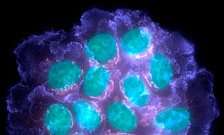A world-first clinical trial to test new imaging technology that can scan tumours during breast cancer surgery has been launched at Guy's and St Thomas' NHS Foundation Trust in collaboration with King's College London.
Two imaging devices, developed by Lightpoint Medical, are being tested to see if they will help surgeons remove breast tumours and cancerous lymph nodes without unnecessarily cutting out healthy tissue.
"We hope this is a major development in cancer surgery – we're taking two steps forward, not just one," says Professor Arnie Purushotham, a surgeon and cancer researcher at Guy's and St Thomas' and King's College London, who is leading the study.
"It should greatly improve surgical accuracy, which is desperately needed because around a quarter of breast cancer patients who have a lump removed need a second operation to remove cancer cells missed in the first surgery.
"Another exciting step is that we will also be scanning lymph nodes, which are often removed during breast cancer surgery. If we can tell on-the-spot which lymph nodes can be safely left, it will improve survivors' quality of life by reducing the chance of them developing lymphoedema, which is painful swelling in their arm that can last for the rest of their life. The number of breast cancer survivors is expected to rise significantly in the next decade, so this is hugely important."
After a breast tumour is removed, it is tested to check that all the cancer cells have been successfully extracted. If any are found close to the surface of the tissue that has been cut out the patient has to have a second operation to remove more tissue. The tests results can take up to a week to come back, which means patients have an anxious wait before being given the 'all clear' or being told they need more surgery.
50,000 women, and a small number of men, are diagnosed with breast cancer every year in the UK. Around 65% will survive for 20 years or more.
Professor Purushotham says: "There are so many potential benefits for both patients and the NHS. If this clinical trial works as we hope, patients will have peace of mind that their cancer surgery is likely to be successful first time around and the next stage of their cancer treatment, chemotherapy or radiotherapy, won't be delayed.
"It will also free up NHS theatres to treat even more patients so waiting lists should be reduced. It's a win-win situation all round, especially as it has good potential to be extended to surgery for other cancers."
How it works
The two new devices being trialled are based on Cerenkov Luminescence Imaging. Patients are injected with small amounts of a radioactive imaging agent that is taken up by the tumour cells, which 'tags' them.
LightPath is a fixed scanner. The tumour is put inside the scanner after it is removed from the patient. The instrument takes just a few minutes to scan the tumour's surface, and so can be done during the operation. Two Guy's and St Thomas' patients have already had their tumours scanned in this way.
Six-months into the trial, the surgeons will also begin using EnLight, a flexible fibre optic camera that can scan inside the breast. After the tumour has been removed the surgeons will check the remaining breast tissue with EnLight, to ensure none are tagged with the radioactive marker. The study will also investigate whether surgeons could use EnLight to help them decide if a patient's lymph nodes need to be removed.
The technology could also be used for surgery for other common cancers such as lung and prostate cancer.
Iain Gray, Chief Executive of the Technology Strategy Board, which is funding the trial: "The TSB is proud to be investing in and supporting this exciting project which has brought the expertise of academia, NHS and industry together. It is being developed by a clinical team with real focus and commitment and demonstrates just how world-leading advances become possible through such innovative collaboration."
Provided by King's College London





















